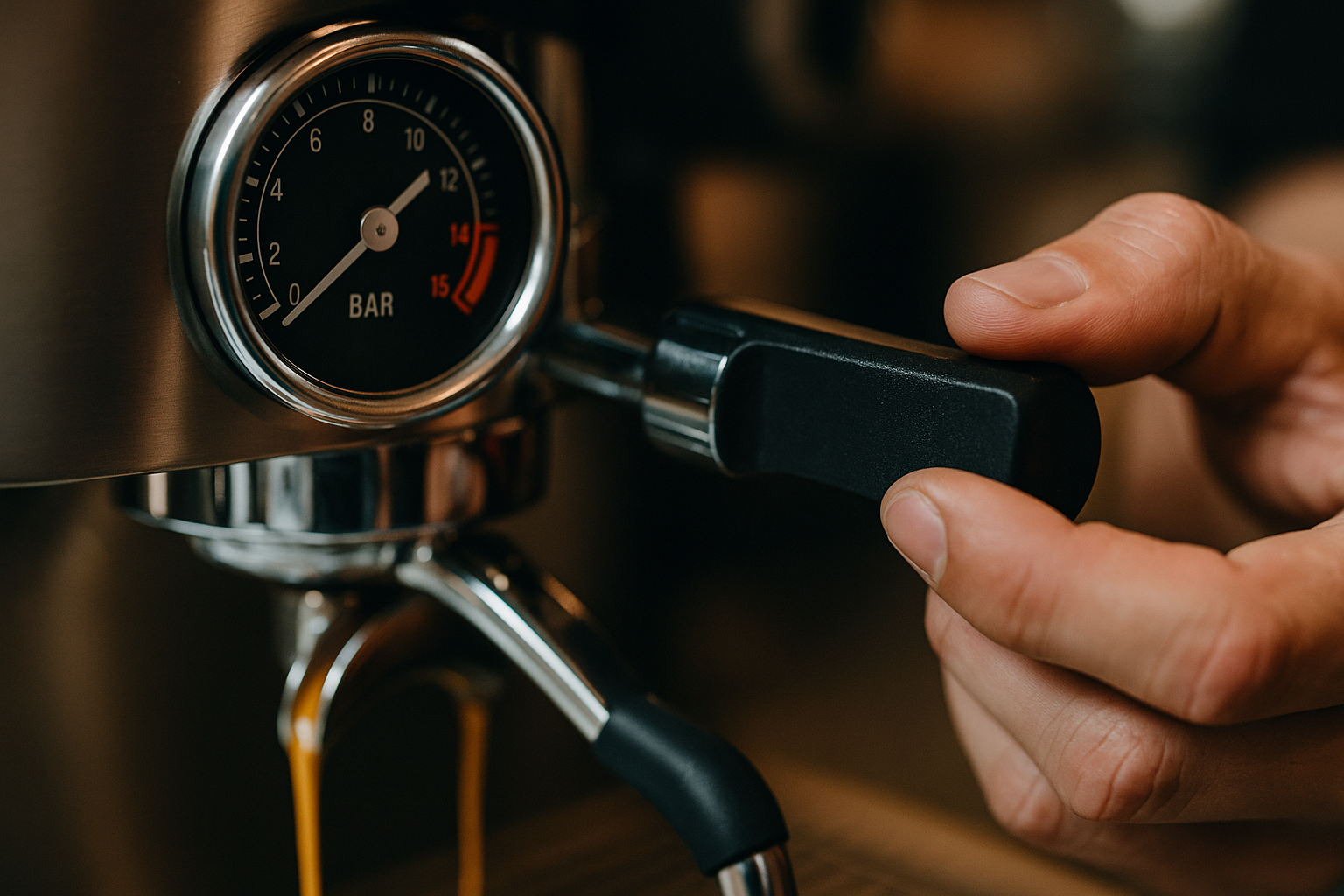Pressure is the force that pushes hot water through finely ground coffee to create espresso.]
It’s measured in bars, with 1 bar equal to the atmospheric pressure at sea level. A standard espresso machine operates at 9 bars—nine times the pressure of our atmosphere.
But pressure isn’t just a number. It plays a key role in:
- Extraction time and flow rate
- Crema formation
- Flavor balance (acidity, sweetness, bitterness)
- Body and mouthfeel
Understanding how pressure works—and how to control it—lets you fine-tune every shot to your preferred taste.
The Standard: 9 Bars and Why It Matters
Most commercial espresso machines are calibrated to extract at 9 bars of pressure. This number came from years of industry testing and represents a sweet spot for:
- Pushing water through fine grounds
- Creating a creamy crema
- Balancing speed and flavor extraction
- Avoiding over- or under-extraction
More pressure doesn’t always mean better. In fact, machines set at 15–19 bars (often found in budget models) can overextract or produce bitter shots if not regulated properly.
What Creates Pressure in an Espresso Machine?
The heart of pressure generation lies in the pump. There are a few types:
1. Vibration Pumps
- Common in home machines
- Inexpensive and compact
- Slightly noisy and less consistent
- Found in models like Gaggia Classic Pro, Breville Barista Express
2. Rotary Pumps
- Quieter and longer-lasting
- Provide consistent pressure
- Allow external pressure adjustment
- Used in commercial machines and high-end home setups
3. Manual Levers
- You apply the pressure physically
- Allows full control of pressure curve
- Requires experience and strength
- Found in La Pavoni, Flair, and Cafelat Robot
Each type creates a different pressure profile. Some baristas even prefer manual for its expressiveness and shot flexibility.
Pressure and Flow Rate
Pressure and flow rate are closely connected. More pressure = faster water flow—up to a point.
Too much pressure can:
- Compensate for too fine a grind, choking the shot
- Lead to overextraction of bitter compounds
- Push water through without proper flavor development
Too little pressure can:
- Cause underextraction (sour, thin shots)
- Create weak crema
- Reduce body
The grind, dose, tamp, and pressure must all work in harmony.
What Is Pressure Profiling?
Pressure profiling is the ability to change the pressure during extraction, not just set it and forget it.
With pressure profiling, you might:
- Pre-infuse at low pressure to saturate the puck gently
- Ramp up to 9 bars, then taper off for a smooth finish
- Pulse pressure to experiment with flavor layers
This adds a new dimension to espresso craft—allowing creative control over shot structure.
Some machines with pressure profiling:
- Slayer Espresso (manual paddle)
- Decent DE1 (digital pressure curves)
- La Marzocco GS3 AV with profile options
- Lelit Bianca (manual paddle)
Pre-Infusion: The Hidden Step
Pre-infusion is a brief period of low-pressure water contact (1–4 bars) before full pressure is applied.
It helps:
- Reduce channeling
- Allow grounds to swell evenly
- Improve crema and extraction balance
- Prevent early overextraction
Even machines without advanced profiling can simulate pre-infusion by pulsing the pump or manually pausing extraction early.
Best results often come from 2–6 seconds of pre-infusion, depending on roast and grind.
Pressure vs. Taste: How It Affects the Cup
| Pressure Behavior | Taste Result |
|---|---|
| Fast ramp to 9 bars | Bright acidity, higher body |
| Slow ramp up | Softer, rounder flavor |
| Declining pressure | Cleaner finish, enhanced sweetness |
| High constant | Dense body, but can introduce bitterness |
| Low constant (6–7) | Light, tea-like body, low crema |
Experimenting with pressure lets you customize taste more than with grind or dose alone.
Pressure Gauges and What to Watch For
Most espresso machines have a pressure gauge showing pump or brew pressure.
- A gauge that shows while brewing is most useful
- Pressure should stabilize around 8–9 bars during extraction
- Watch for drops or spikes—they can indicate issues with the puck, channeling, or grind
If pressure rises too high and no espresso flows, your grind may be too fine, or you may have tamped too hard.
If pressure is low and flow is fast, the grind may be too coarse or the dose too small.
Advanced Tools for Pressure Management
Flow Control Mods
- Installed on E61 group heads
- Let you manually adjust pressure during shot
- Great for experimenting with pre-infusion and decline curves
Digital Scales + Shot Timers
- Help correlate pressure changes to yield and flavor
- Can be used to track pressure vs. weight vs. time
Pressure Profiling Machines
- Fully programmable or paddle-controlled
- Can save pressure curves for consistent flavor outcomes
- Ideal for specialty cafés or experimental baristas
These tools expand your control beyond standard espresso variables.
When to Adjust Pressure and Why
You might want to adjust pressure if:
- You’re using a light roast that tastes hollow → increase pressure slightly
- Your dark roast is too bitter → try lower pressure or decline at end
- You want to experiment with mouthfeel and crema texture
- You’re troubleshooting channeling or uneven flow
Always test one variable at a time. Use pressure adjustments with intention.
Espresso Pressure in Café Workflow
In a high-volume setting, pressure consistency is vital.
- Machines with fixed 9-bar systems are ideal for speed
- Pressure profiling requires more attention and training
- Many cafés opt for simple pre-infusion + steady 9-bar setups
If using profiling in a café, document pressure curves and train all baristas to replicate them.
Final Thoughts: Pressure Is Power
Pressure is at the core of espresso—literally. It creates the crema, unlocks body, and shapes flavor in seconds.
Learning how to read, adjust, and control pressure puts you in the driver’s seat of espresso craft. It transforms pulling a shot from habit to intention.
So the next time you brew, don’t just watch the shot. Watch the pressure. And let it guide your hand toward balance, beauty, and better taste.

Artur is a coffee enthusiast and content creator passionate about barista techniques and coffee culture. With a sharp eye for detail and a love for learning, he shares practical tips, brewing guides, and gear insights to help readers elevate their coffee experience — from home brewers to aspiring professionals.
